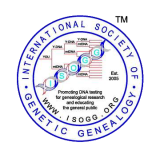Setting up the DNA project website
From ISOGG Wiki
Setting up the DNA project website is one of the first tasks of a project administrator.
Family Tree DNA provides a courtesy website which is easy to set up and user friendly. It is recommended that all projects should have a basic FTDNA website. For projects that are compiling results from other (or multiple) companies/labs, you may consider establishing your website on a free server, such as Google Sites or Rootsweb Freepages. Worldfamilies.net also offers up to five free webpages for FTDNA projects.
Check out other admins websites to develop ideas for layouts and information you wish to include.
To track visitors to your DNA project website it is helpful to add a hit counter. Free counters may be obtained from www.rapidcounter.com or Statcounter.com. The html code can be cut and pasted into the website. (A small size is recommended).
Info template
- Include your goals for the project.
- You may also wish to list participant "prospects" (a description of participants you desire to participate).
- List all surname variations that you would welcome to participate in the project. It may also be helpful to list the origin of the surname.
- You might wish to include text to "welcome" participants of the National Geographic Genographic Project. See sample wording and additional tips.
- DNA collection method - (Example: DNA is extracted painlessly from buccal cells (saliva/cheek cells) Include a link to Dave Dorsey's "Collection Method" webpage.
- Eligibility - Describe who is eligible to participate in the project.
- When results are available, include a chart of the DYS values on your site. List the participants' by their ancestor's name, test kit number, or an assigned code, unless you have their permission to list their real name.
- Include a bio or reference of the participants' ancestry.
- Test pricing
- Information and definitions of terminology used (i.e.: haplogroups, etc.)
- Project results
- Understanding the results
- Include a link for contributions to your project's "General Fund" as well as recognizing those individuals who contribute. (They may prefer to remain anonymous, so you may wish to ask their permission first.)
- Update the site regularly with the project's progress and successes. If you have any, list testimonials to the successes as well.
- You may wish to include cautionary information regarding the occurrence of non-matches due to non-paternity events. (See: "Using Genetic Genealogy to Solve Non-Paternal Event (NPE) Roadblocks")
- Include the link to join your project.
- Include your e-mail.
- You may wish to state that you are not paid, or an employee affiliated with the DNA testing company.
- If you are an ISOGG member, you may list it on the site and/or add the logo.
- If your project is with FamilyTreeDNA and you are a member of, or your surname is listed with the Guild of One-Name Studies, you can contact their DNA Advisor to ask for their logo to be added to your project listing.
- Include the text at the bottom: “© 20XX (website URL) All Rights Reserved”. You may also wish to include when the project was started and the date when the page was last updated, and if you desire more specific "fair use" instructions, consider adding a Creative Commons license. To add the license, visit www.creativecommons.org and choose the license that suits you. When you click on that license, a box with HTML text will appear on the following page. Highlight or select all of the text in the box, copy, and paste it into the bottom of the HTML page. You might also consider adding additional verbiage above the license to specify your wishes more precisely, i.e.: "Information and data obtained from the (Name of Project Here) must be attributed to the project, administrator, and (Testing Company/Lab name here) as outlined in the Creative Commons License. Please notify administrator when using data for public or private research."
